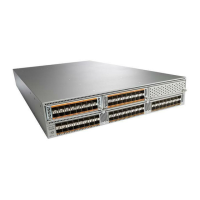•
VSANs can meet the needs of a particular department or application.
VSAN Advantages
VSANs offer the following advantages:
• Traffic isolation—Traffic is contained within VSAN boundaries and devices reside only in one VSAN
ensuring absolute separation between user groups, if desired.
• Scalability—VSANs are overlaid on top of a single physical fabric. The ability to create several logical
VSAN layers increases the scalability of the SAN.
• Per VSAN fabric services—Replication of fabric services on a per VSAN basis provides increased
scalability and availability.
• Redundancy—Several VSANs created on the same physical SAN ensure redundancy. If one VSAN
fails, redundant protection (to another VSAN in the same physical SAN) is configured using a backup
path between the host and the device.
• Ease of configuration—Users can be added, moved, or changed between VSANs without changing the
physical structure of a SAN. Moving a device from one VSAN to another only requires configuration
at the port level, not at a physical level.
Up to 256 VSANs can be configured in a switch. Of these, one is a default VSAN (VSAN 1), and another is
an isolated VSAN (VSAN 4094). User-specified VSAN IDs range from 2 to 4093.
VSANs Versus Zones
Zones are always contained within a VSAN. You can define multiple zones in a VSAN.
Because two VSANs are equivalent to two unconnected SANs, zone A on VSAN 1 is different and separate
from zone A in VSAN 2. The following table lists the differences between VSANs and zones.
Table 16: VSAN and Zone Comparison
Zone CharacteristicVSAN Characteristic
Routing, naming, and zoning protocols are not
available on a per-zone basis.
VSANs equal SANs with routing, naming, and zoning
protocols.
Zones limit unicast traffic.VSANs limit unicast, multicast, and broadcast traffic.
Membership is typically defined by the pWWN.Membership is typically defined using the VSAN ID
to F ports.
An HBA or storage device can belong to multiple
zones.
An HBA or a storage device can belong only to a
single VSAN (the VSAN associated with the F port).
Zones enforce membership only at the source and
destination ports.
VSANs enforce membership at each E port, source
port, and destination port.
Cisco Nexus 5000 Series NX-OS SAN Switching Configuration Guide, Release 5.2(1)N1(1)
118 OL-27583-01
Configuring and Managing VSANs
Information About VSANs

